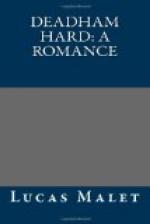TELLING HOW, UNDER STRESS OF CIRCUMSTANCE, A HUMANIST TURNED HERMIT
A peculiar magic resides in running water, as every student of earth-lore knows. There is high magic, too, in the marriage of rivers, so that the spot where two mingle their streams is sacred, endowed with strange properties of evocation and of purification. Such spots go to the making of history and ruling of individual lives; but whether their influence is not more often malign than beneficent may be, perhaps, open to doubt.
Certain it is, however, that no doubts of this description troubled the mind of Thomas Clarkson Verity, when, in the closing decade of the eighteenth century, he purchased the house at Deadham Hard, known as Tandy’s Castle, overlooking the deep and comparatively narrow channel by which the Rivers Arne and Wilner, after crossing the tide-flats and salt-marsh of Marychurch Haven, make their swift united exit into Marychurch Bay. Neither was he troubled by the fact that Tandy’s Castle—or more briefly and familiarly Tandy’s—for all its commonplace outward decency of aspect did not enjoy an unblemished moral or social reputation. The house—a whitewashed, featureless erection—was planted at right angles to the deep sandy lane leading up from the shore, through the scattered village of Deadham, to the three-mile distant market town of Marychurch.
Standing on a piece of rough land—bare, save for a few stunted Weymouth pines, and a fringe of tamarisk along the broken sea-wall—Tandy’s, at the date in question, boasted a couple of bowed sash-windows on either side the front and back doors; and a range of five other windows set flat in the wall on the first floor. There was no second storey. The slate roofs were mean, low-pitched, without any grace of overshadowing eaves. At either end, a tall chimney-stack rose like the long ears of some startled, vacant-faced small animal. Behind the house, a thick plantation of beech and sycamore served to make its square blank whiteness visible for a quite considerable distance out to sea. Built upon the site of some older and larger structure, it was blessed—or otherwise—with a system of vaults and cellars wholly disproportionate to its existing size. One of these, by means of a roughly ceiled and flagged passage, gave access to a heavy door in the sea-wall opening directly on to the river foreshore.
Hence the unsavoury reputation of the place. For not only did it supply a convenient receiving house for smuggled goods, but a convenient rendezvous for the more lawless characters of the neighbourhood—a back-of-beyond and No Man’s Land where the devil could, with impunity, have things very much his own way. In the intervals of more serious business, the vaults and cellars of Tandy’s frequently resounded to the agonies and brutal hilarities of cock-fights, dog-fights, and other repulsive sports and pastimes common to the English—both




